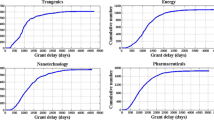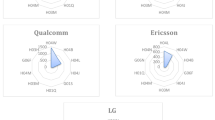Abstract
For efficient research and development (R&D) management, estimating the economic value of patents is becoming increasingly necessary. When estimating the economic value of patents, technology lifetime is one of the most important factors to be considered. The Pareto/non-negative binomial distribution (NBD) model is a stochastic model that can estimate the technology lifetime based on patent citation data. However, the Pareto/NBD model has some limitations. First, the model assumes that the technology of a patent is active until it is cited by another patent even though the cited patent is expired. Second, the probability distribution of the technology lifetime for a patent group always has a mode of zero, which implies that patent technologies are immediately replaced by other technologies. To address these issues, we propose a more generalized method that estimates the technology lifetime of a patent based on a modified gamma Gompertz with NBD (G/G/NBD) model. We apply the proposed methodology to estimate the lifetime of US patents in three communication-related technology areas. The case study and sensitivity analysis showed reliable estimates by the proposed methodology, where technology lifetimes were estimated within the patents’ term based on the proposed model while the existing model often resulted in their estimated lifetime being greater than the patent term.







Similar content being viewed by others
Notes
Korea Institute of Science and Technology Information.
References
Abramowitz, M., & Stegun, I.A. (1972). Handbook of mathematical functions with formulas, graphs, and mathematical tables. National Bureau of Standards Applied Mathematics Series, 55. Tenth Printing.
Archana, K. (2013). Do we need patent protection to biotechnology inventions? International Journal of Scientific and Research Publications, 3(4), 1–5.
Bandarian, R. (2007). Measuring commercial potential of a new technology at the early stage of development with fuzzy logic. Journal of Technology Management and Innovation, 2(4), 73–85.
Bemmaor, A. C., & Glady, N. (2012). Modeling purchasing behavior with sudden “death”: A flexible customer lifetime model. Management Science, 58(5), 1012–1021.
Bosworth, D., & Jobome, G. (2003). The rate of depreciation of technological knowledge: Evidence from patent renewal data. Economic Issues-Stoke on Trent, 8(1), 59–82.
Bouabid, H. (2011). Revisiting citation aging: A model for citation distribution and life-cycle prediction. Scientometrics, 88(1), 199–211.
Byun, J., Sung, T.-E., & Park, H.-W. (2018). Technological innovation strategy: How do technology life cycles change by technological area. Technology Analysis and Strategic Management, 30(1), 98–112.
Ernst, H. (1997). The use of patent data for technological forecasting: The diffusion of CNC-technology in the machine tool industry. Small Business Economics, 9(4), 361–381.
Fader, P. S., Hardie, B. G., & Lee, K. L. (2005). RFM and CLV: Using iso-value curves for customer base analysis. Journal of Marketing Research, 42(4), 415–430.
Fader, P. S., Hardie, B. G., & Shang, J. (2010). Customer-base analysis in a discrete-time noncontractual setting. Marketing Science, 29(6), 1086–1108.
Fagbohun, O. (2014). Comparative studies on 3G, 4G, and 5G wireless technology. IOSR Journal of Electronics and Communication Engineering, 9(3), 88–94.
Ford, D., & Ryan, C. (1981). Taking technology to market. Harvard Business Review (United States), 59(2), 117–126.
Gao, L., Porter, A. L., Wang, J., Fang, S., Zhang, X., Ma, T., Wang, W., & Huang, L. (2013). Technology life cycle analysis method based on patent documents. Technological Forecasting and Social Change, 80(3), 398–407.
Haupt, R., Kloyer, M., & Lange, M. (2007). Patent indicators for the technology life cycle development. Research Policy, 36(3), 387–398.
Hikkerova, L., Kammoun, N., & Lantz, J.-S. (2014). Patent life cycle: New evidence. Technological Forecasting and Social Change, 88, 313–324.
Hwang, J. T., Kim, B. K., & Jeong, E. S. (2021). Patent value and survival of patents. Journal of Open Innovation: Technology, Market, and Complexity, 7(2), 119.
Isaac, G. E., & Kerr, W. A. (2004). Bioprospecting or biopiracy? Intellectual property and traditional knowledge in biotechnology innovation. The Journal of World Intellectual Property, 7(1), 35–52.
Jaffe, A. B., & Trajtenberg, M. (1999). International knowledge flows: Evidence from patent citations. Economics of Innovation and New Technology, 8(1–2), 105–136.
Lee, C., Cho, Y., Seol, H., & Park, Y. (2012). A stochastic patent citation analysis approach to assessing future technological impacts. Technological Forecasting and Social Change, 79(1), 16–29.
Lee, C., Kim, J., Kwon, O., & Woo, H. G. (2016). Stochastic technology life cycle analysis using multiple patent indicators. Technological Forecasting and Social Change, 106, 53–64.
Lee, Y. G., Lee, J. D., Song, Y. I., & Lee, S. J. (2007). An in-depth empirical analysis of patent citation counts using zero-inflated count data model: The case of KIST. Scientometrics, 70(1), 27–39.
Lin, D., Liu, W., Guo, Y., & Meyer, M. (2021). Using technological entropy to identify technology life cycle. Journal of Informetrics, 15(2), 101137.
Liu, L., Cao, C., & Song, M. (2014). China’s agricultural patents: How has their value changed amid recent patent boom? Technological Forecasting and Social Change, 88, 106–121.
Nagula, M. (2016). Forecasting of Fuel cell technology in hybrid and electric vehicles using Gompertz growth curve. Journal of Statistics and Management Systems, 19(1), 73–88.
Narin, F. (1994). Patent bibliometrics. Scientometrics, 30(1), 147–155.
Pakes, A., & Schankerman, M. (1984). The rate of obsolescence of patents, research gestation lags, and the private rate of return to research resources. R&D, patents, and productivity (pp. 73–88). University of Chicago Press.
Park, Y., & Park, G. (2004). A new method for technology valuation in monetary value: Procedure and application. Technovation, 24(5), 387–394.
Patra, S., & Krishna, V. (2015). Globalization of R&D and open innovation: Linkages of foreign R&D centers in India. Journal of Open Innovation: Technology, Market, and Complexity, 1(1), 7.
Redner, S. (1998). How popular is your paper? An empirical study of the citation distribution. The European Physical Journal B-Condensed Matter and Complex Systems, 4(2), 131–134.
Santos, J. B., & Irizo, F. J. O. (2005). Modelling citation age data with right censoring. Scientometrics, 62(3), 329–342.
Schmittlein, D. C., Morrison, D. G., & Colombo, R. (1987). Counting your customers: Who-are they and what will they do next? Management Science, 33(1), 1–24.
Seol, S. S. (2000). A theoretical framework for the valuation of technology. Journal of Korea Technology Innovation Society, 3(1), 5–21.
Shrieves, R. E., & Wachowicz, J. M., Jr. (2001). Free cash flow (FCF), economic value added (EVA™), and net present value (NPV): A reconciliation of variations of discounted-cash-flow (DCF) valuation. The Engineering Economist, 46(1), 33–52.
Song, H., Hou, J., & Zhang, Y. (2022). Patent protection: Does it promote or inhibit the patented technological knowledge diffusion? Scientometrics, 127, 1–29.
Su, C.-Y., Lin, B.-W., & Chen, C.-J. (2015). Technological knowledge co-creation strategies in the world of open innovation. Innovation, 17(4), 485–507.
Sung, T.-E., & Park, H.-W. (2017). Elaboration of real options model and the adequacy of volatility. Asian Journal of Innovation and Policy, 6(2), 225–244.
Trajtenberg, M. (1990). A penny for your quotes: Patent citations and the value of innovations. The RAND Journal of Economics, 21, 172–187.
Utterback, J. M., & Abernathy, W. J. (1975). A dynamic model of process and product innovation. Omega, 3(6), 639–656.
Watts, R. J., & Porter, A. L. (1997). Innovation forecasting. Technological Forecasting and Social Change, 56(1), 25–47.
Yoo, S.-H., Kim, B., & Jeong, M. K. (2015). Modelling of technology lifetime based on patent citation data and segmentation. Journal of the Operational Research Society, 66(3), 450–462.
Yoon, J., & Kim, K. (2012). An analysis of property–function based patent networks for strategic R&D planning in fast-moving industries: The case of silicon-based thin film solar cells. Expert Systems with Applications, 39(9), 7709–7717.
Zhang, H., Daim, T., & Zhang, Y. P. (2021). Integrating patent analysis into technology roadmapping: A latent dirichlet allocation based technology assessment and roadmapping in the field of Blockchain. Technological Forecasting and Social Change, 167, 120729.
Author information
Authors and Affiliations
Corresponding author
Ethics declarations
Conflict of interests
The authors have no conflict of interest to declare.
Appendix: estimation of mean, mode, and median of the technology lifetime
Appendix: estimation of mean, mode, and median of the technology lifetime
In this Appendix, the mean, mode, and median of the technology lifetime distribution are estimated based on the G/G/NBD model. First, the mean value of a probability distribution is a natural way to estimate the lifetime. The mean lifetime of the patent group is obtained by computing the expectation using the pdf in Eq. (3), as in (Bemmaor & Glady, 2012):
where \({{}_{2}F}_{1}\left(\widehat{s},1;\widehat{s}+1;\frac{\widehat{\beta }-1}{\widehat{\beta }}\right)\) denotes a Gaussian hypergeometric function and \(\hat{b}\), \(\hat{s}\), and \(\hat{\beta}\) denote the estimated parameters. In addition, we can estimate the mode of the technology lifetimes at which the probability of a patent in the group being inactive is maximized. To derive the mode of the technology lifetime, we set equal to zero the first derivative of Eq. (3) with respect to \(\tau\). The estimated mode of the technology lifetime is given by
Lastly, we derive the median lifetime of a patent group. Let \(F\left(\tau |b,s,\beta \right)\) be the cumulative distribution function of the G/G model pdf in Eq. (3):
The median lifetime of a patent group can be obtained by finding \({\tau }^{*}\) such that \(F\left({\tau }^{*}|b,s,\beta \right)\) is equal to 0.5:
When \(b\), \(s>0\) and \(\beta \ne 1\), there exists a unique solution because the CDF in (6) increases monotonically in \(\tau\). Solving (7) for \(\tau\), the median of the technology lifetime is given by:
When \(b\), \(s>0\) and \(\beta =1\), Equation (7) becomes
and the median is given by
Finally, we obtain the median of the technology lifetimes, as shown in Equation (8).
Rights and permissions
Springer Nature or its licensor holds exclusive rights to this article under a publishing agreement with the author(s) or other rightsholder(s); author self-archiving of the accepted manuscript version of this article is solely governed by the terms of such publishing agreement and applicable law.
About this article
Cite this article
Choi, M., Yoo, SH., Lee, J. et al. A modified gamma/Gompertz/NBD model for estimating technology lifetime. Scientometrics 127, 5731–5751 (2022). https://doi.org/10.1007/s11192-022-04489-1
Received:
Accepted:
Published:
Issue Date:
DOI: https://doi.org/10.1007/s11192-022-04489-1




